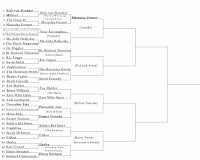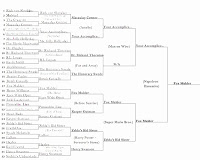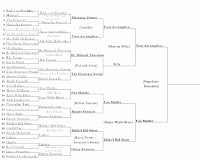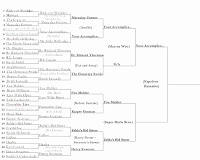Wow! What a turnout! There were 30+ votes before Day 1 had even ended. 66 at the end! That’s the most of any battle so far! And the winner still only won by two votes. I guess everyone really was excited to move on to Round 2, huh? And it was back-and-forth the entire time. I was honestly never sure who was going to grab the win. But in the end, it turned out to be Macaulay Connor. Congrats! For this next battle, we’ll see Your Accomplice in the Wood Chipper take on Ms. Jolly Holly-day. Your Accomplice… won Round 1 in North by Northwest, while Ms. Jolly Holly-day actually got a free pass due to her opponent dropping out at the last minute (but still to positive feedback in the comments) with her review of The Mist. But today they’re looking at Akira Kurosawa’s Yojimbo. Read, vote, comment, enjoy! You have until Friday. The updated bracket is below. Click to make it bigger.
—————–
Review #1
By Your Accomplice in the Wood Chipper
Akira Kurosawa has never denied the fact that he was heavily influenced by the western genre, citing John Ford, amongst others, as something of an idol. It’s fitting then that at least two of the Japanese director’s most prominent works, this and Seven Samurai, would go on to be remade, unofficially yet almost shot-for-shot in Yojimbo’s case, as two of the definitive classics of the western genre. Though I’ve seen Seven Samurai once before, and The Magnificent Seven and Sergio Leone’s Dollars trilogy a fistful of times each, this was my first viewing of Kurosawa’s classic. Yojimbo sees a lone, nameless samurai wander into a town divided by two warring gangs. Seeing an opportunity to rectify the situation, and possibly pocket a little something along the way, the ronin stays in town and pits the two rival factions against one another.
The solitary sword swinger is Toshiro Mifune, with whom Kurosawa had a similar relationship as Ford did with John Wayne, working together on 16 pictures in total. Upon his arrival into the one-road town, the samurai – who later calls himself Kuwabatake Sanjiro (meaning Mulberry Thirty), though he freely admits this is a sudonym – hires himself out to both gang lords. Neither the henpecked, frustrated Seibei nor his foe and former right hand man Ushi-tora outright trust this professional blade-for-hire, yet his opponent accepting the fighter’s offer would guarantee their victory. When everything seems to be going according to Sanjiro’s plans, with the two tribes threatening to wipe one another out, complications arise with the arrival of Ushi-tora’s brother Unosuke, brandishing a pistol.
The gun clearly poses quite a threat to our heroic samurai, as now the skill has been removed from the kill. Previously, Sanjiro had no great challenge within the town – other than maybe the lumbering giant with the comically oversized mallet – but now Unosuke, despite his arrogance, ridiculous posturing and insistence on carrying the gun inside his kimono – looking like he’s wearing a sling and hiding a pot belly – has taken the upper hand. No longer is the killer simply the smarter, faster, more skilled competitor; now it is the man with his finger on the trigger.
Throughout the film, Sanjiro’s motives are never clarified. Is he out for payment? Justice? Peace? Or is he simply seeking entertainment, something he clearly achieves as the two clans fight for his allegiance and to pay for his sake. His allegiance changes as often as the direction of the wind, and one of the most memorable scenes occurs as Sanjiro opts out of a confrontation he himself instigated, yet had no intention of taking part in. Instead, he heads atop a vantage point to watch as the two gangs reluctantly face off against one another, faux-lunging and backing away until only a few feet apart. Were it not for the arrival of a town inspector checking up on them, it’s likely this stalemate could have lasted forever.
Inspired by two of Dashiell Hammett’s film noirs, Red Harvest and The Glass Key, the film has a far greater comedic tone than I was expecting. Be it the odd-couple relationship between the tavern keeper and the persistently noisy coffin maker next door (the only townsperson making a profit from the constant fighting), the boorish stupidity of Ushi-tora’s other brother Inokichi as he struggles to work out that four dead enemies is better than two dead allies, or the belittling wife of his rival, there is much here to gain amusement from. Even serious moments, such as Sanjiro overhearing a plot to double cross and murder him, are juxtaposed by the man waggling both tongue and eyebrow at the young harem girls eavesdropping with him.
The film’s western influence isn’t merely seen in its lone ‘gun’-man story. From wide shots with a character stood alone in the distance, to high noon showdowns with gangs positioned at either end of a one-road town, it seems every shot, character and plot point is a loving homage to the director’s favourite genre. The wind even rustles leaves around in place of rolling tumbleweeds. Exposition is handled swiftly and elegantly via the tavern keeper who takes the samurai in and feeds him, regardless of his lack of funds. Sliding screen panels transform what would otherwise be a static, uneventful dialogue scene into an almost comic-book like affair, with each window shifting aside to reveal the disparate groups at either end of the town. The sliding panel is a recurring theme throughout the film, with many shots taking place inside buildings looking out, and later using the more traditional screen-wipe edit.
If I had to pick some minor flaws with the film, I’d mention that the all-too-brief combat scenes don’t quite live up to their pulse-quickening build ups, and that some of the more minor characters come off as little more than caricatures, instead of fully rounded individuals, but this is nit-picking more than anything else. I’d also heard that there were some intense and gory bursts of violence, and although there are certainly small explosions of slice’n’dice fury, fortunately they weren’t as gruesome as I was led to believe – and of course my expectations are no fault of the film’s.
For the most part the acting is stellar, particularly from Mifune, who plays the wandering samurai with a confident swagger, a sly smirk and an imposing stance. Every inch the typical lone ‘gunslinger’, Mifune is incomparable as the professional killer, his only master the fate that led him to the village; via the direction a falling stick pointed towards. Like a coiled spring, he is able to dish out far more than you might expect, and though it is clearly signposted by the rousing score and natural progression of the scenes, his swordsmanship often comes as much of a shock to us as those on the more uncomfortable end of his blade. Upon first entering the town, the man is greeted by a small dog scampering past, clutching a severed human hand in its mouth. At a sight like this, any other man would have had the sense to turn tail and flee, but Sanjiro – with a look of hilarious incredulity creeping across his face – nonetheless ventures on, possibly in search of the one-armed man this appendage-gnawing mutt has left behind.
The final showdown – because it’s a western, so there has to be a final showdown – has a setup shot of such simple elegance it’d be beautiful, were it not for the haggard, near-dead old man trussed up and dangling at the front of the frame. The ability to pan the camera around the decrepit victim, always keeping him in frame whilst progressing the scene, is a masterful stroke, assisted by Mifune’s Sanjiro stalking ever-closer towards the finale – a ten against one fight to the death – as a tornado of dust swirls up around him. What follows, alas, fails to match that establishing shot for artistry and effect, and also features an almost ridiculously drawn out death, but is nonetheless riveting and satisfying.
Whilst it’s not quite as good as Kurosawa’s other great remade eastern-western, Seven Samurai, Yojimbo is at least shorter, making it the perfect choice for a samurai fix if you’ve got two hours rather than three and a half.
——————————–
Review #2
By Ms. Jolly Holly-day
I’m humbled to be back for another stab at reviewing and it seems I’m definitely being tested for competency in reviewing anything and everything. It’s not revealing too much about me to say that I’m pretty xenophobic when it comes to what I watched so when I was given Yojimbo in this second round I expected to be bored to tears. Fortunately, our intrepid competition organizer gave me I film I found myself enjoying although not as surprising to me as when I discovered The Mist. Yojimbo is a samurai film imbued with elements of the American Western making it highly accessible for even the most jaded film viewer. With a calculating performance by star Toshiro Mifune, Yojimbo is a film that deserves being listed as one of the best.
A man known only as Sanjuro (Mifune) enters a corrupt town controlled by two rival gangs. Sanjuro devises a scheme to pit the gangs against each other, using his services as a bodyguard, in order to wipe them out and bring harmony to the city. Unfortunately, his double dealings end up falling back on him leaving the samurai to figure out how to escape with his life.
Can I just say that opening theme is beautiful and instantly sets you up for a story of discord, heightened by the clashing sounds of the music. The town itself is set- up as wanton, lawless, where everyone wants to make “easy money.” I mentioned director Akira Kurosawa introduces universal themes and genres and the opening may showcase the world of a quick dollar but there’s a subtle humor that runs throughout, as introduced by a father, angry at his son saying that the kids today are crazy (some things never change). By the time Sanjuro, and the audience sees the dog walking past with a human hand (that’s been seen in countless films since so now I can say I know the reference) you’re invested in the world Kurosawa has created.
The Western influences take over from here and even the most casual viewer can identify with this as a Western (other sources mention film noir influences as well but I connected deeper with the Western roots) from the rival gangs to the lone gunslinger and the corrupt town led by an equally corrupt mayor. When Sanjuro is warned that the town will “gain him nothing but evil” and is filled with “men who deserve to die” I half- expected John Wayne or Gary Cooper to walk in (apparently Kurosawa saw that too as a particular moment has a child announcing it’s noon…high noon perhaps?).
It helps that star Mifune and adversary Tatsuya Nakadai inhabit their roles completely. Mifune is given a lot of John Wayne-esque material to work with including some witty one-liners (Thug: “Kill us if you can!” Sanjuro: “It’ll hurt”). He deftly plays both sides and you’re never truly sure how you’re supposed to take him, especially when the gangs start to fight and he just sits on the roof, reveling in the impending battle. He’s the definition of the antihero, and I’d use him as a shining example to the Hollywood directors today who don’t seem to understand the meaning of the word. He doesn’t expect praise or desire it, even when a man and his grateful wife are kneeling before him, he simply calls them “weaklings.” Opposite him is Nakadai who could have walked over the line into “evil Asian stereotype” but skirts it well. Sure the way he pulls out his gun is a little corny, and flamboyant, but the way he’s trying to double-cross right till the end showcases his dying determination to the cause of kicking Sanjuro’s ass!
Kurosawa even takes the time to inject gallows humor and dry wit into the film, something I didn’t expect considering the Asian cinema I’ve seen is very serious. I mentioned the dog with the hand above but the gangs are hilarious for their incompetence. The first battle, that never happens, is set up and filmed like a tennis match with gangs on both sides and Sanjuro on a tower like a referee. From there neither gang wants to strike first and let each other off “light” when they discover a reason to end the battle before it’s begun! Once both gang leaders decide Sanjuro is needed they try to flatter him; the warlord’s wife who planned to kill him tell Sanjuro she was simply joking! You want these people to die purely because they’re morons. Once their money is threatened they can secure a truce, emphasizing their fickle and greedy nature, they’re made for each other and yet they can’t live with each other.
I could mention all the “cool violence” but I don’t think that’s the movies sole strength. There’s a smart and effective plot with amazing acting that I think trumps the action and the blood spatter. Honestly, that’s what I assumed Yojimbo would be: mindless action with a bad plot (I’m stupid for thinking that since this is a Criterion title). Not to mention by the end Sanjuro leaves the town as nonchalantly as he entered proving that the film isn’t about the battle but the man. I’ve heard there are sequels to this film and I’m not sure I’d watch them. I’m still not sure if samurai films are my forte, but I did enjoy this. It’s a solid watch that took me down some surprising paths!
Grade: B
————————–
Vote Now!








Although Your Accomplice obviously knows a bit more about Kurosawa, and maybe enjoyed the film a little bit more, I found his/her review inconsistent and difficult to follow. Vote goes to Ms. J. H-d for writing an accessible piece that is more successful in piquing my interest.
The competition is really heating up in round 2! Again, these are two very strong reviews. Went with YAitWC because, despite a couple of minor nitpicks, his review touched a little more on the technical aspects.
I actually thought Your Accomplice in the Wood Chipper was a little easier to follow. I got hung up a couple times in Ms. Holly-Jolly Day’s review. I agree that they are both very well written, but my vote went to YAitWC.
Both pieces do well in explaining what they believe works and doesn’t work with their films, but a minor issue I had with both (and this might be an altogether personal bugbear) is the inclination both seem to have to compare YOJIMBO to other films, for the first it’s to other Kurosowa films for the second it’s to what it assumed it’d be. Of course, preconceived notions and comparisons are impossible to have, but it sort of robs the reviews of the film specifically from standing on its own since that quality seems to betray baggage in both reviews.
I wanna make sure I understood this. You don’t think a movie review should compare a film with…another film? Did I read that right? I just wanna make sure I read that right.
-Jason
I don’t think the comparison should be the main thrust of the review.
Unless it’s a part of a series or it’s explicitly a comparative analysis, yes I think including constant comparisons to other films should be kept at a minimum in a single review. It could easily lead to a murky situation where the review of film A becomes “film does X good….but film B does it better”.
(Neither of these reviews reach that point, so my initial comment is admittedly somewhat obiter dictum.